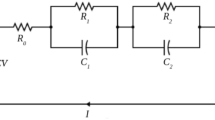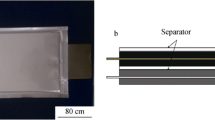Abstract
The thermal behavior of pouch-type lithium-ion batteries during discharge and charge cycles is investigated by numerical simulation. A transient thermal model using finite element method software is developed through the modification of an electrochemical-thermal model. The developed model is validated with experimental data. For the experiment, a 304252 pouch cell is fabricated and tested in the laboratory. This model captures the dynamic responses of temperature, and distributions of current density and temperature, during discharge and charge cycles. Our results indicate that the discharge temperature is higher than the charge temperature at cut-off voltage. The temperature distribution upon discharge is similar to that of charge. On the other hand, different temperature distributions are observed at various C rates. The temperature profiles obtained from modeling and experiment are in good agreement.











Similar content being viewed by others
Abbreviations
- c :
-
Lithium concentration (mol L−1)
- C p :
-
Heat capacity (J kg−1 K−1)
- D :
-
Diffusion coefficient (m2 s−1)
- F :
-
Faraday constant (96,485 C mol−1)
- \(\Delta H\) :
-
Enthalpy change of chemical reaction (J mol−1)
- h :
-
Heat transfer coefficient (W m−2 K−1)
- i :
-
Current density (A m−2)
- I :
-
Applied current (A)
- k :
-
Charge-transfer rate coefficient [A m−2 (m3 mol−1)2/3]
- L :
-
Thickness (m)
- n :
-
Charge number pertaining to the reaction
- \(\dot{q}\) :
-
Heat generation per unit volume (W m−3)
- r p :
-
Radius of electrode particles (m)
- r :
-
Rate of reaction (mol s−1)
- R :
-
Electrical resistance (Ω m)
- ΔS :
-
Entropy change (J mol−1 K−1)
- t :
-
Time (sec)
- T :
-
Temperature (K)
- V :
-
Voltage (V)
- V o :
-
Open circuit voltage (V)
- x:
-
Li content in LixMn2O4
- y:
-
Li content in LiyC6
- ε:
-
Volume fraction
- φ:
-
Electrical potential (V)
- κ:
-
Thermal conductivity (W m−1 K−1)
- σ:
-
Electrical conductivity (S m−1)
- ρ:
-
Density (kg m−3)
- \(\upsilon\) :
-
Volume (m3)
- 1:
-
Electronic (solid) phase
- 2:
-
Ionic (liquid) phase
- PCC:
-
Positive current collector
- PE:
-
Positive electrode
- NCC:
-
Negative current collector
- NE:
-
Negative electrode
- Max:
-
Maximum
References
Bernardi D, Pawlikowski E, Newman J (1985) A general energy balance for battery systems. J Electrochem Soc 132:5–12
Chen Y, Evans J (1993) Heat transfer phenomena in lithium polymer-electrolyte batteries for electric vehicle application. J Electrochem Soc 140:1833–1838
Newman J, Tiedemann W (1995) Temperature rise in a battery module with constant heat generation. J Electrochem Soc 142:1054–1057
Pals C, Newman J (1995) Thermal modeling of the lithium/polymer battery. J Electrochem Soc 142:3274–3281
Thomas K, Newman J (2003) Thermal modeling of porous insertion electrodes. J Electrochem Soc 150:A176–A192
Srinivasan V, Wang CY (2003) Analysis of electrochemical and thermal behavior of li-ion cells. J Electrochem Soc 150:A98–A106
Onda K, Kameyama H, Hanamoto T, Ito K (2003) Experimental study on heat generation behavior of small lithium-ion secondary batteries. J Electrochem Soc 150:A285–A291
Inui Y, Kobayashi Y, Watanabe Y, Watase Y, Kitamura Y (2007) Simulation of temperature distribution in cylindrical and prismatic lithium ion secondary batteries. Energy Convers Manag 48:2103–2109
Kwon KH, Shin CB, Kang TH, Kim CS (2006) A two-dimensional modeling of a lithium-polymer battery. J Power Sources 163:151–157
Kim US, Shin CB, Kim CS (2008) Effect of electrode configuration on the thermal behavior of a lithium-polymer battery. J Power Sources 180:909–916
Forgez C, Vinh Do D, Friedrich G, Morcrette M, Delacourt C (2010) Thermal modeling of a cylindrical LiFePO4/graphite lithium-ion battery. J Power Sources 195:2961–2968
Jeon DH, Baek SM (2011) Thermal modeling of cylindrical lithium ion battery during discharge cycle. Energy Convers Manag 52:2973–2981
Kim US, Yi J, Shin CB, Han T, Park S (2011) Modelling the thermal behavior of a lithium-ion battery during charge. J Power Sources 196:5115–5121
Kim GH, Smith K, Kim KJ, Santhanagopalan S, Pesaran A (2011) Multi-domain modeling of lithium-ion batteries encompassing multi-physics in varied length scales. J Electrochem Soc 158:A955–A969
Ye Y, Shi Y, Cai N, Lee J, He X (2012) Electro-thermal modeling and experimental validation for lithium ion battery. J Power Sources 199:227–238
Xiao M, Choe SY (2012) Dynamic modeling and analysis of a pouch type LiMn2O4/carbon high power Li-polymer battery based on electrochemical-thermal principles. J Power Sources 218:357–367
Yi J, Kim US, Shin CB, Han T, Park S (2013) Three-dimensional Thermal Modeling of a lithium-ion battery considering the combined effects of the electrical and thermal contact resistances between current collecting tab and lead wire. J Electrochem Soc 160:A437–A443
Wang BJ, Hilali SY (1995) Electrical-thermal modeling using ABAQUS. 1995 ABAQUS user’s conference, Paris, pp 771–785
ABAQUS Analysis User’s Manual, Version 6.10 (2010) Dassault Systemes Simulia Corp, Providence, RI
Doyle M, Newman J, Gozdz A, Tarascon JM (1996) Comparison of modeling predictions with experimental data from plastic lithium ion cells. J Electrochem Soc 143:1890–1903
Baker D, Verbrugge M (1999) Temperature and current distribution in thin-film batteries. J Electrochem Soc 146:2413–2424
Yue H, Huang X, Lv D, Yang Y (2009) Hydrothermal synthesis of LiMn2O4/C composite as a cathode for rechargeable lithium-ion battery with excellent rate capability. Electrochim Acta 54:5363–5367
Perry RH, Green DW (1997) Perry’s Chemical Engineers’ Handbook, 7th edn. McGraw Hill, New York
Holman JP (1986) Heat transfer, 6th edn. McGraw-Hill, Singapore
Thomas KE, Bogatu C, Newman J (2001) Measurement of the entropy of reaction as a function of state of charge in doped and undoped lithium manganese oxide. J Electrochem Soc 148:A570–A575
Ramadass P, Haran B, White R, Popov B (2002) Capacity fade of Sony 18650 cells cycled at elevated temperatures: Part I. Cycling performance. J Power Sources 112:606–613
Ramadass P, Haran B, White R, Popov B (2003) Mathematical modeling of the capacity fade of Li-ion cells. J Power Sources 123:230–240
Ramadass P, Haran B, Gomadam PM, White R, Popov B (2004) Development of first principles capacity fade model for Li-ion cells. J Electrochem Soc 151:A196–A203
COMSOL Multyphisics User’s Guide, Version 3.5a (2008) COMSOL AB
Valoen LO, Reimer JN (2005) Transport properties of LiPF6-based Li-ion battery electrolyte. J Electrochem Soc 152:A882–A891
Albertus P, Christensen J, Newman J (2009) Experiments on and modeling of positive electrodes with multiple active materials for lithium-ion batteries. J Electrochem Soc 156:A606–A618
Darling R, Newman J (1999) Dynamic Monte Carlo simulations of diffusion in LiyMn2O4. J Electrochem Soc 146:3765–3772
Kim SW, Pyun SI (2001) Thermodynamic and kinetic approaches to lithium intercalation into Li1-δMn2O4 electrode using Monte Carlo simulation. Electrochim Acta 46:987–997
Less GB, Seo JH, Han S, Sastry AM, Zausch J, Latz A, Schmidt S, Wieser C, Kehrwald D, Fell S (2012) Micro-scale modeling of Li-ion batteries: parameterization and validation. J Electrochem Soc 159:A697–A704
Ohzuku T, Iwakoshi Y, Sawai K (1993) Formation of lithium-graphite intercalation compounds in nonaqueous electrolytes and their application as a negative electrode for a lithium ion (shuttlecock) cell. J Electrochem Soc 140:2490–2498
Acknowledgments
This work was supported by the Dongguk University Research Fund of 2012.
Author information
Authors and Affiliations
Corresponding author
Rights and permissions
About this article
Cite this article
Song, JH., You, SJ. & Jeon, D.H. Numerical modeling and experimental validation of pouch-type lithium-ion battery. J Appl Electrochem 44, 1013–1023 (2014). https://doi.org/10.1007/s10800-014-0723-x
Received:
Accepted:
Published:
Issue Date:
DOI: https://doi.org/10.1007/s10800-014-0723-x




